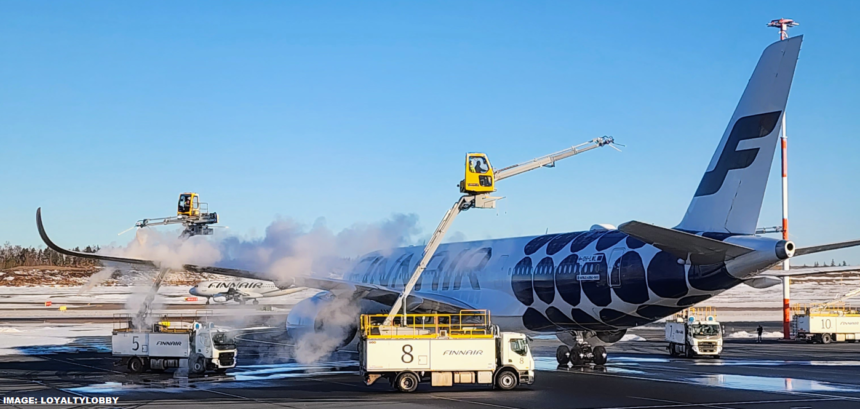Finnair and its Pilot Union have been negotiating a new agreement for months without much success, and pilots went on strike for a couple of days in December (read more here) that was followed by a ban on standby and overtime duty (read more here) that had lead to 10 to 15 flight cancellations daily.

Now Finnair is threatening its Pilot Union about possibly sacking or furloughing up to 90 pilots unless they reach a new agreement, and partially blames their Qantas operations for this, as they have wet leased two aircraft with crew from Finnair that operate flights from Sydney to Bangkok and Singapore.
You can access Finnair here.
The wet lease agreement with Finnair and Qantas for two A330s lasts for two years and is then followed by a dry lease of 2.5 years, during which Qantas personnel will operate the flights on Finnair aircraft (the difference between wet and dry leases).
These flights that Finnair has operated for Qantas have outsourced Bangkok and Singapore-based cabin crew, but the cockpit has Finnish pilots who have been stationed in Sydney per the releases below and rotated to Finland at times.
Finnair blames the current ban on standby and overtime duty is threatening these flights that they operate for Qantas, while the Pilot Union states that a separate agreement covers them and are not affected by the current work action.
Nevertheless, the Finnair-provided pilots are unnecessary when Qantas takes over these two A330s in October 2025 and early 2026.
The reason behind these aircraft utilization issues and wet lease agreements to others (Finnair has operated flights on behalf of British Airways and Lufthansa Group) is the closure of Russian airspace that overnight ended Finnair’s Asia strategy and has made the airline pivot flights to North America instead.
The “fight” between Finnair and its Pilot Union is not only about pay but on-call agreements as well that have been on a voluntary base previously but which Finnair would like to have codified on the official agreement.
Finnair’s Press Release:
Finnair starts change negotiations with pilots as industrial action can impact Finnair’s cooperation agreement
Finnair will start change negotiations with its pilots to discuss the possible need for personnel reductions that may arise if the ongoing industrial action by pilots leads to changes in Finnair’s cooperation agreement. Negotiations start on 12 February to discuss a possible reduction or furlough of a maximum of 90 pilots. The negotiations will also discuss a plan to introduce the established stand-by practice into pilots’ employment contracts, as the Finnish Transport Pilots’ Association (SLL) has announced its reluctance to collectively agree on stand-by duty in a collective agreement.
Two of Finnair’s A330 aircraft have been wet leased by another carrier, flying with Finnair crew between Sydney and Bangkok and Singapore. The range of the A330 aircraft limits their use in Finnair’s Asian network after the Russian airspace closure, and this collaboration has allowed Finnair to put its A330s into productive use, employing approximately 90 pilots. Finnair has a total of approximately 1 000 pilots.
In connection with the collective labour negotiations for pilots that have been ongoing since autumn, the Pilot’s union has extended industrial action, including a stand-by ban, to cover the flights operated for the partner carrier as well as the flights that pilots use to transfer to these flights. This impacts Finnair’s ability to operate the flights as agreed, and Finnair has initiated discussions with its partner on future options for the cooperation agreement, with one option being termination of the agreement. This would have a direct impact on the amount of work available to Finnair pilots.
“It is sad that the pilot union’s prolonged industrial action has led to a situation where we have to start change negotiations. Today is a tough day for all of us at Finnair,” says Kaisa Aalto-Luoto, Finnair’s Chief People Officer. “In our 101 years of history, we have never needed to reduce pilot positions due to operational reasons. Even when the Russian airspace closed and fundamentally changed our operating environment, we succeeded in securing employment for our pilots with collaboration arrangements.”
The change negotiations will also cover inclusion of stand-by duty in employment contracts, as the pilot union has refused to agree on stand-by duties collectively and proposed that stand-by should always be voluntary. For decades, stand-by duty has been part of the collective labour agreements for Finnair pilots. The stand-by duty is an essential part of ensuring reliable operation of flights at airlines.
“Stand-by is an established practice in the industry and I believe that every Finnair pilot recognizes it as part of their job. As the union has declined to agree on this, we are now preparing to include stand-by duty in the employment contracts of all pilots in order to secure regular and reliable flight operations,’ Aalto-Luoto says.
Collective agreement negotiations between the Finnish Transport Pilots’ Association (SLL) and Service Sector Employers Palta ry concerning Finnair pilots have now been going on for more than five months and under the leadership of the National Conciliator since November. The negotiations have not yielded results, and the pilot union has rejected several settlement proposals that the employer would have accepted.
Finnish Arline Pilots’ Association’s Rebuttal:
7.2.2025 Finnish Airline Pilots’ Association’s Statement Regarding Finnair’s Restructuring Negotiations
On February 7, Finnair announced restructuring negotiations related to the ongoing collective bargaining talks with the Finnish Airline Pilots’ Association (SLL). The company justified the need for these negotiations due to the two long-haul aircraft leased to Sydney and the potential disruptions caused by future labor disputes on these operations. Additionally, Finnair aims to force every pilot employed by the company to accept an on-call condition as part of their employment contract.
The collective bargaining negotiations have been ongoing for nearly six months, during which SLL has carried out moderate and legal strike actions for less than three months. Meanwhile, Finnair has implemented two lockouts, outsourced legal strike-related flight work to external operators, and forced commercial pilots to work in violation of the collective bargaining agreement. The company has also stated it will withhold wages based on whether the pilot follows SLL’s strike guidance. In November, Finnair unilaterally stopped paying the agreed pay supplement for pilots, despite it being subject to the general retroactive effect.
“The collective bargaining negotiations have been prolonged, which is why the use of strike actions has also extended. We deeply regret the inconvenience caused to our passengers, for whom we do this work. From the beginning, the employer’s approach has been aggressive, and as a small union, we have no other means of defending our rights except through legal strikes,” says SLL President Vesa Uuspelto.
Flights to Australia Secured During Strike
Despite the difficulties in collective bargaining, SLL and Finnair were able to reach a local agreement regarding Sydney operations in December. The Sydney agreement covers the same flight operations that are now affected by the restructuring negotiations.
The Sydney agreement outlines the operational arrangements for the leased Airbus A330 aircraft servicing Australia. This agreement is applicable even during strike actions. SLL’s ban on overtime will extend in March to include operations between Helsinki and Sydney, but these will not affect the arrangements specified in the Sydney agreement.
“The company’s justification for the restructuring negotiations is completely implausible, as SLL has protected the Sydney operation throughout the negotiation process, and our intention is to ensure the reliability of these operations through the arrangement agreed upon in the Sydney agreement last December. I find it completely incomprehensible that Finnair is unwilling to operate Sydney traffic as agreed, preferring instead to cancel flights and forgo their revenue,” Uuspelto expresses in amazement.
According to Uuspelto, operating traffic on the other side of the world has caused pilots very long and repeated absences from home, as well as significant jet lag. This is why an arrangement was made with Finnair that allows operations to be carried out by pilots stationed in Sydney rather than in Helsinki.
“I am deeply disappointed that, despite our local Sydney agreement, the company is not taking the concerns of pilots and the observed health impacts seriously. What I find unprecedented, however, is that the company is attempting to pressure us in collective bargaining with this already agreed-upon issue. The responsibility for ensuring the safety of operations lies with Finnair, not with the employees,” Uuspelto emphasizes.
Employer Attempts to Force Change in On-Call System
With the legislative reform promoting local agreements, SLL’s position in collective bargaining has changed. This is the first time that negotiations have allowed, among other things, discussions on whether the union should collectively impose on-call obligations on individual commercial pilots. Previously, the on-call obligation was established between the employee and employer based on mutual consent, as flight crew tasks were not generally considered on-call work. However, the employer now demands that SLL collectively force all pilots into on-call duties.
“From the beginning, SLL has stated that we are happy to maintain the current on-call system, which we believe has worked smoothly for both Finnair and the pilots. Despite this, we have been willing to negotiate a reform of the on-call arrangement in a binding way. We have made proposals on this, which the company has rejected. The employer’s claims about SLL’s unwillingness to negotiate and demands for voluntary on-call duty changes are completely false,” says Uuspelto.
Employer organizations are attempting to push all legislative changes made for their benefit into the collective agreements without compensating employees. SLL is a very small union with only a thousand members, and it is challenging for them to stand up against the coordinated efforts of employer organizations and a large state-owned public company. In the negotiations, the employer has refused to engage in genuine dialogue.
“As I have stated before, our negotiations are not only about the amount of pay increases but also about the unreasonable demands from the employer. It is increasingly clear that the promotion of local agreements effectively means local coercion. The terms of employment are dictated to employees. In these negotiations, the employer is attempting to force SLL to agree to semi-dispositive legislation to the detriment of the employees – now, most recently, through restructuring negotiations. I believe the labor market system is broken. Is this really what the lawmakers intended with the expansion of local agreements?” Uuspelto wonders.
The Finnish Airline Pilots’ Association (SLL) has been negotiating a new collective agreement for Finnair’s commercial pilots since August. The negotiations reached the national conciliator’s office in November due to lockouts organized by the employer. Compulsory mediation has continued almost uninterrupted since then, under the guidance of mediators Anu Sajavaara and Nina Pärssinen, but without results.
Conclusion
So, here, Finnair is essentially threatening to fire/furlough some pilots unless they can come up with an agreement with Pilot Union regarding pay and on-call arrangements.
You have to remember that these on-call arrangements can be quite disruptive for the person, as they must be able to report at the airport within a specific time frame and obviously must rearrange personal schedules at very short notice, such as children’s daycare.
I’m not sure how many pilots Finnair doesn’t require due to Qantas taking over the operations of these two A330 within the next 12 months. Usually, each long-haul plane requires 5 to 6 crews to operate, so that is somewhere between 20 to 30 pilots.
So, why would they need to furlough more pilots unless Finnair plans to drylease more airplanes to outside operators?







